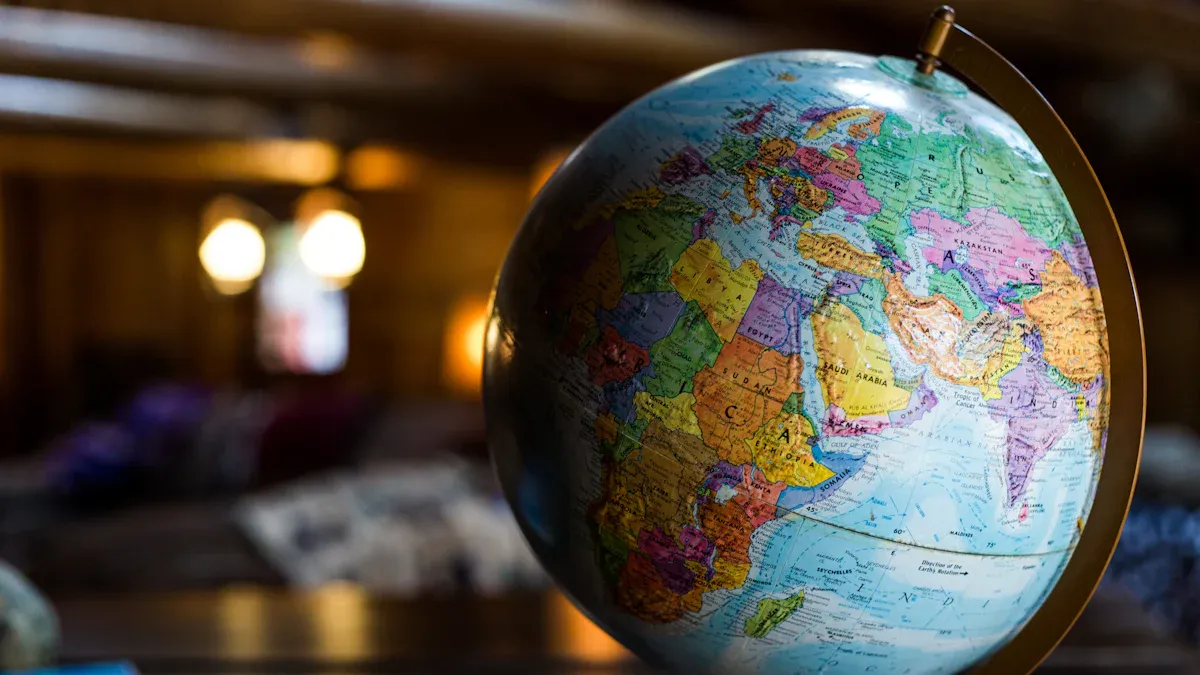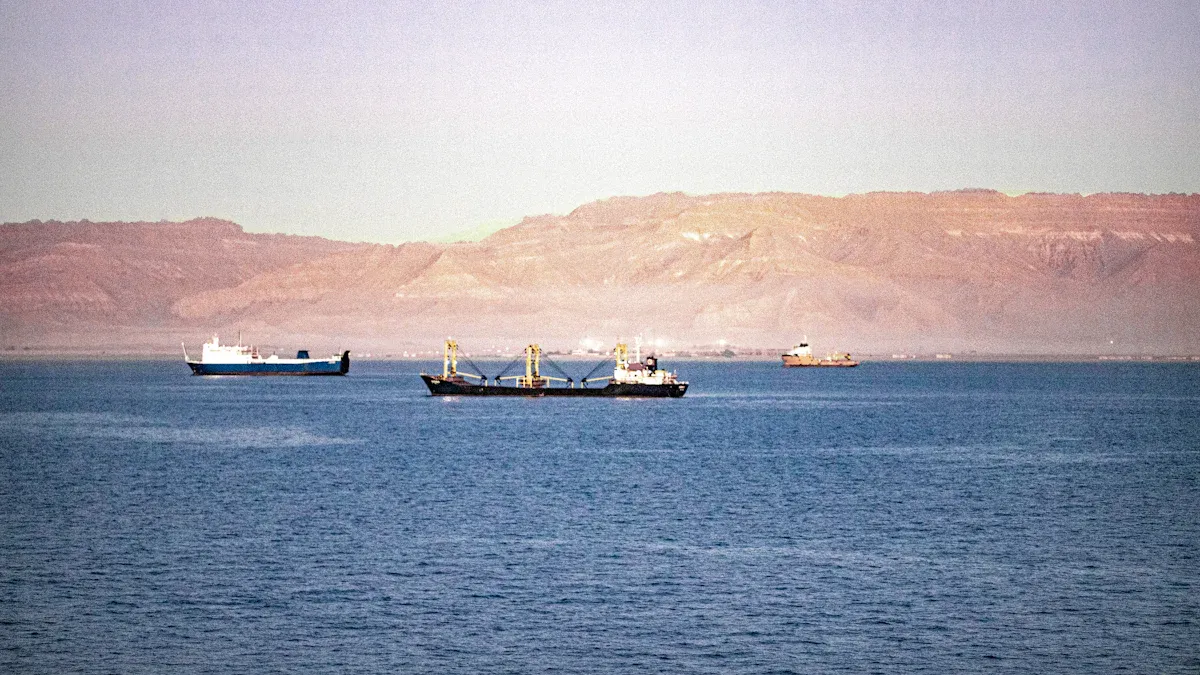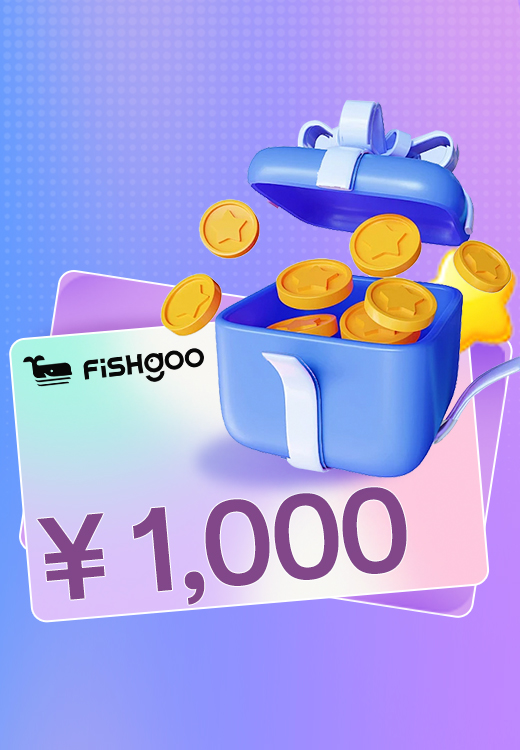Global Shipping Lanes: Major Routes, Chokepoints, and Their Impact on International Trade

You need global shipping lanes for most things you use. Over 80% of trade uses ships to move goods. Major routes like the English Channel and Strait of Malacca carry lots of cargo. Problems on these routes make deliveries slower and cost more. FISHGOO helps you deal with these shipping problems.
Key Takeaways
Global shipping lanes are very important for trade. They move more than 80% of goods around the world. Knowing about these routes helps you see how products get to you.
Chokepoints like the Suez Canal and Panama Canal matter a lot for shipping. Issues at these places can cause delays and make things cost more. Good planning is needed to avoid problems.
Services like FISHGOO help with shipping problems. They give real-time updates and flexible choices. This helps your orders arrive safely and on time.
Global Shipping Lanes Overview
Major Maritime Shipping Routes
You use global shipping lanes all the time, even if you do not notice. Ships carry most goods around the world on busy routes. These routes link different continents and bring you things from far away.
Some of the most important maritime shipping routes are:
The English Channel is the busiest ocean shipping lane. More than 500 ships go through it every day.
The Strait of Malacca moves about 30% of traded goods. It connects the Indian and Pacific Oceans.
The Suez Canal makes trips between Europe and Asia shorter. This helps trade move faster.
The Panama Canal joins the Atlantic and Pacific Oceans. Almost 14,000 ships use it each year.
The Strait of Hormuz carries a lot of the world’s oil. About 21 million barrels pass through daily.
You can look at the table below to see how these maritime corridors work:
Route Name | Origin and Destination Regions | Main Transported Goods | Characteristics | Important Ports |
|---|---|---|---|---|
Far East - Europe Route | East Asia to Europe | Clothing, electronics, machinery | Long trip, lots of trade, uses Suez Canal | Shanghai, Rotterdam, Hamburg |
Far East - North America | East Asia to North America | Consumer goods, industrial goods | High demand, uses Panama Canal | Qingdao, Los Angeles, New York |
North America - Europe | North America to Europe | Cars, chemicals, agriculture | Connects two big economies | New York, London, Antwerp |
Persian Gulf - Far East | Persian Gulf to Asia | Oil and oil products | Very important for oil, uses large ships | Dubai, Ningbo, Singapore |
Why These Routes Matter
You get cheaper and faster products because of good maritime shipping routes. These routes help countries trade goods over long distances for less money than by air or land. When ships use global shipping lanes, you can buy more types of products.
Maritime shipping routes also help global trade by linking countries and moving big loads easily. Technology and real-time data help ships avoid being late, so shipping is more dependable.
If you use FISHGOO, you can use these good routes. FISHGOO helps you pick the best shipping, so your orders come safely and on time.
Key Choke Points

You use global shipping lanes every day. Many of these lanes go through narrow places called chokepoints. A maritime chokepoint is a tight spot where lots of ships must pass. These places are very important for trade and the military. Chokepoints that lead to big oceans can change who has power during fights. When you learn about these chokepoints, you see why shipping can be risky and why good planning is needed.
Suez Canal
The Suez Canal is in Egypt. It joins the Mediterranean Sea and the Red Sea. This canal is important because it links Europe and Asia.
About 12% of world trade goes through here each year.
Nearly 30% of container traffic uses the canal.
Ships move energy, goods, and parts through it.
Big problems have shown how one event can stop trade.
The Suez Crisis in 1956 made oil prices go up and slowed trade.
The canal was closed from November 1956 to April 1957. This stopped two-thirds of Europe’s oil from coming in.
In 2021, the Ever Given blocked the canal. Over 100 ships were stuck, and the world lost $15 to $17 billion.
FISHGOO helps you deal with these risks. FISHGOO watches shipping news and picks the best routes for your orders, even when chokepoints like the Suez Canal have trouble.
Panama Canal
The Panama Canal links the Atlantic and Pacific Oceans. You find it in Central America. It is a main chokepoint for trade between North America, South America, and Asia.
In 2024, 11,240 ships crossed the canal. They moved 210 million long tons of cargo.
Main goods are containers, coal, grains, minerals, metals, oil, fuels, and chemicals.
Problems can slow down shipping.
Bad droughts from El Niño made fewer ships pass each day.
In 2023, only 22 ships could go through daily instead of 36.
Ships waited 9 to 20 days. Many took longer routes, which cost more and took extra time.
FISHGOO’s experts watch canal conditions and change shipping plans. You get your delivery on time, even when chokepoints like the Panama Canal have delays.
Strait of Malacca
The Strait of Malacca is between Malaysia and Indonesia. It is one of the busiest shipping lanes in the world.
Over 15 million barrels of oil go through every day. This is about one-third of all oil shipped by sea.
The strait is important for energy and trade between Asia, the Middle East, and Europe.
Safety problems have made shipping hard here.
In 2005, the strait was called high-risk because of pirates.
Working together helped lower piracy, but in 2023, there were 38 cases. This was a 41% jump from 2022.
Tensions and new trade rules also change how much trade happens.
FISHGOO uses live data and strong partners to keep your shipments safe. You get smart route choices and help with risks when shipping through chokepoints like the Strait of Malacca.
Strait of Hormuz
The Strait of Hormuz is between Oman and Iran. It is the most important oil chokepoint in the world.
About 21 million barrels of oil and fuel go through each day. This is 30% of all oil shipped by sea.
Around 4 trillion cubic feet of LNG move through each year. That is over a quarter of the world’s LNG trade.
Fights and problems often make shipping less safe.
Scenario | What Happens to Oil Prices and Shipping Reliability |
|---|---|
Complete Closure | Oil prices go way up, shipping routes get blocked. |
Partial Disruption | Shipping costs rise, markets get shaky. |
Problems here can make gas, diesel, and jet fuel cost more in Asia.
Governments may limit fuel, and business can slow down.
FISHGOO’s global team helps you avoid delays and price jumps. You get flexible shipping and insurance for valuable goods going through chokepoints like the Strait of Hormuz.
Bab el-Mandeb
The Bab el-Mandeb Strait links the Red Sea and the Gulf of Aden. It is between Yemen and Djibouti.
This strait connects Asia, Africa, and Europe. It is a key route for oil and dry goods.
About 30% of oil and 40% of dry goods move through the Red Sea and Suez Canal, showing Bab el-Mandeb’s importance.
Recent events have made shipping harder.
Event Description | Impact on Shipping Traffic |
|---|---|
Houthi attacks on shipping traffic | Higher costs, less traffic, and more insurance needed. |
Sinking of ships (2 sunk, 7 destroyed, 8 set ablaze) | Shipping stopped, and safety worries grew. |
Shift to alternative routes (Cape of Good Hope) | Trips from Asia to Europe got longer by 3,000 miles and 10 days. |
FISHGOO’s team watches for safety news and changes routes when needed. You can relax knowing your goods will arrive safely, even when chokepoints like Bab el-Mandeb have trouble.
You can see how these main chokepoints affect global trade. FISHGOO’s skills help you handle tough shipping routes, avoid delays, and get your orders on time.
Impact on Global Trade
Trade Volume and Goods
You need global shipping lanes for most things you use. These routes move lots of goods across oceans. They connect countries and continents. The numbers show how much trade depends on these lanes. Look at the table to see yearly trade volume and value at big chokepoints:
Chokepoint | Annual Trade Volume | Trade Value |
|---|---|---|
Turkish Straits | 480 million tons | $300 billion |
Malacca | 23.7% of global seaborne trade | > $2.8 trillion |
Suez Canal | 1 billion tons | > $950 billion |
The Suez Canal moves over 1 billion tons each year. Its trade value is more than $950 billion. The Strait of Malacca handles almost a quarter of all sea trade. It is very important for shipping.
The goods that travel these lanes matter a lot. You get oil, electronics, clothes, cars, and food from many places. Here is a table showing what goes through busy shipping lanes:
Shipping Lane | Types of Goods Transported |
|---|---|
English Channel | Cargo, passenger ferries, cruise ships, oil tankers |
Suez Canal | Crude oil, goods between Europe and Asia |
Strait of Hormuz | |
Strait of Malacca | Oil shipments |
Oil shipments are common on many routes. This makes energy prices go up if there is a problem. When you buy things from other countries, you benefit from smooth shipping lanes.
Risks and Disruptions
There are risks when goods move through chokepoints. Problems at these narrow places can slow or stop trade. Here are some common causes:
Water level problems at the Panama Canal
Attacks by Houthi rebels in the Red Sea
Limits on trade through Bab el-Mandeb
Other risks are fights between countries, bad weather, and pirates. These issues cause delays, higher costs, and sometimes shortages. For example, crowded ports can slow down big hubs. Ships may need to take longer routes. This can cost $400,000 more for each big ship trip. Longer trips mean your orders take more time. Prices can go up, with global prices expected to rise by 0.6% by 2025.
Tip: You can lower your risk by picking a logistics partner like FISHGOO. FISHGOO offers package grouping, insurance, and flexible shipping. You get more control over your deliveries, even when shipping lanes have problems.
Economic Effects
Shipping problems affect you in many ways. When a canal or chokepoint has trouble, supply chains get hurt. You may pay more at stores or wait longer for orders. Here are some main effects:
Rerouting ships can add hundreds of thousands of dollars per trip.
Global prices could go up by 0.6% by 2025. Small Island Developing States may see prices rise by 0.9%. Processed food prices could go up by 1.3%.
Weak economies, like Least Developed Countries, lost 9% of maritime connections in ten years.
Big disruptions caused $88.79 million in losses. This includes ship costs, environmental costs, and inventory costs.
One bottleneck can affect the whole world. When you buy goods from other countries, you depend on steady shipping. FISHGOO helps you handle these risks. You can get Chinese products, group your packages, and pick the best shipping lines. FISHGOO’s insurance and flexible delivery protect your orders and help you avoid extra costs.
Note: FISHGOO’s worldwide reach and expert help give you safe access to global markets, even when trade faces problems.
FISHGOO Shipping Solutions
One-Stop Service
FISHGOO helps you shop from China easily. You can look for products on many Chinese websites. Just copy the product link and paste it into FISHGOO. The platform takes care of your order for you. You pay using your own money, so you do not need a Chinese account. Your items go to a safe warehouse in China. FISHGOO checks your items and sends you pictures. You pick how you want your things shipped to you.
Search for products on top Chinese sites
Place orders with a simple link
Pay with money from your country
Safe warehouse for your items
Quality checks and photo updates
Choose your delivery method
International Logistics Support
FISHGOO makes shopping from other countries simple. You get help in English and can pay with PayPal or Visa. You do not need to read Chinese or make local accounts. You can put items from different stores into one shipment. FISHGOO gives you insurance and strong boxes for safety. You can also get help finding special items. You can track your package and get updates.
English help for easy shopping
Many ways to pay
Combine packages to save money
Insurance and strong packaging
Track your package and get alerts
Warehousing and Consolidation
FISHGOO uses smart storage to save you money and time. Your packages are kept together, so shipping costs less. Fewer shipments mean less work and lower fees. You help the planet by using less packaging. The steps are quick and easy.
Benefit | Explanation |
|---|---|
Lower Shipping Costs | Putting packages together saves money. |
Less Handling Fees | Fewer shipments mean lower fees. |
Less Packaging Waste | Combining orders uses less packaging. |
Easier Shipping Process | Fewer boxes make tracking and paperwork simple. |
FISHGOO’s worldwide service and helpful support make shopping from China easy for you.
Global shipping lanes and chokepoints affect how you get goods. Problems can make things cost more and take longer to arrive. Good partners like FISHGOO help you avoid risks and keep your packages safe.
Key Attributes of Reliable Logistics Partners | Description |
|---|---|
Global reach and multi-modal shipping capabilities | Work in many places and use different ways to ship |
Real-time risk monitoring tools | Watch for problems and fix them fast |
You want quick delivery and to save money. FISHGOO gives you tracking, helpful support, and insurance for your shipments. This helps you feel calm about your orders.
FAQ
What happens if a shipping chokepoint gets blocked?
Your package might arrive late. You could pay more for shipping. FISHGOO watches the news for problems. They change your shipping route fast to help you.
Tip: You can look up your order status on FISHGOO anytime.
How does FISHGOO help you save on shipping costs?
You can put packages from many stores together. FISHGOO uses smart ways to group items. They pick different shipping lines to save you money.
Benefit | How You Save |
|---|---|
Package grouping | You get fewer shipments. |
Route options | You get cheaper delivery. |
Can you shop from Chinese sites without a local account?
You do not need a Chinese phone number. You do not need a Chinese payment account. FISHGOO lets you pay with PayPal, Visa, or MasterCard.
Note: You get help in English for every step.
See Also
Maximizing Your International E-Commerce Logistics For Success
Top Shipping Paths From China To Spain: Costs And Tips
Key Global Shipping Services Every Newbie Needs In 2025
Shopping Online From China: Best Platforms And Shipping Tips
Understanding FISHGOO Proxy Shipping For Expert International Shopping


